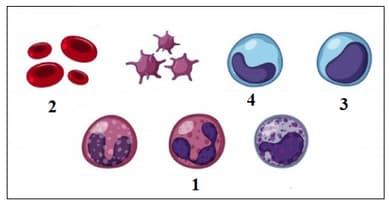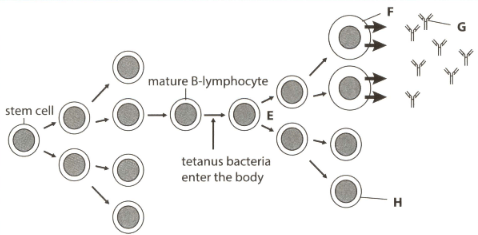Mary Jones, Richard Fosbery, Dennis Taylor and, Jennifer Gregory Solutions for Chapter: Immunity, Exercise 14: EXAM-STYLE QUESTIONS
Mary Jones Biology Solutions for Exercise - Mary Jones, Richard Fosbery, Dennis Taylor and, Jennifer Gregory Solutions for Chapter: Immunity, Exercise 14: EXAM-STYLE QUESTIONS
Attempt the practice questions on Chapter 11: Immunity, Exercise 14: EXAM-STYLE QUESTIONS with hints and solutions to strengthen your understanding. Biology for Cambridge International AS & A Level coursebook 2nd Edition Digital Access solutions are prepared by Experienced Embibe Experts.
Questions from Mary Jones, Richard Fosbery, Dennis Taylor and, Jennifer Gregory Solutions for Chapter: Immunity, Exercise 14: EXAM-STYLE QUESTIONS with Hints & Solutions
A student made drawings of four blood cells as shown in the diagram:

The correct identification of the cells is :
The following occur during the response to infection:
1. Attachment of bacteria to cell surface membrane of phagocyte.
2. Movement of phagocyte to site of infection by bacteria.
3. Formation of phagocytic vacuole.
4. Fusion of lysosomes to the phagocytic vacuole.
5. Infolding of cell surface membrane.
6. Release of enzymes into the phagocytic vacuole.
Which type of immunity is provided by vaccination?
Which describes the cells that produce monoclonal antibodies (Mabs)?
Tetanus is a bacterial disease that may be acquired during accidents in which a wound is exposed to the soil.
B-lymphocytes originate from the stem cells in bone marrow, mature and circulate around the body. Following infection by tetanus bacteria, some B-lymphocytes will become activated as shown in the diagram.

Explain the role of stem cells in the production of lymphocytes.
or reload the browser
or reload the browser
Tetanus is a bacterial disease that may be acquired during accidents in which a wound is exposed to the soil.
B-lymphocytes originate from the stem cells in bone marrow, mature and circulate around the body. Following infection by tetanus bacteria, some B-lymphocytes will become activated as shown in the diagram.
.
Explain how cell H is responsible for long-term immunity to tetanus.
Phagocytes and lymphocytes are both present in samples of blood.
Describe how the structure of a phagocyte differs from the structure of a lymphocyte.
Rearrange the following statements to produce a flow diagram to show how Mabs are produced.
1. Hybridoma cells are cultured.
2. Mouse is injected with antigen.
3. Mouse plasma cells are fused with cancer cells.
4. Hybridoma cells that make an appropriate antibody are cloned.
5. Mouse B-lymphocytes that recognise the antigen become plasma cells.
